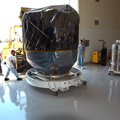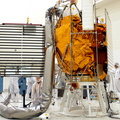
WIKIARCHIVES.SPACE
The Human Spaceflight Archive

Information
- Taken in
- Kennedy Space Center
- Autor
- NASA
- Descrição
- At Astrotech in Titusville, Fla., technicians with The Johns Hopkins University Applied Physics Laboratory (APL) monitor the progress of the solar array deployment on the MESSENGER spacecraft. The two panels will provide MESSENGERs power on its journey to Mercury. MESSENGER is scheduled to launch Aug. 2 aboard a Boeing Delta II rocket from Pad 17-B, Cape Canaveral Air Force Station, Fla. It will return to Earth for a gravity boost in July 2005, then fly past Venus twice, in October 2006 and June 2007. The spacecraft uses the tug of Venus gravity to resize and rotate its trajectory closer to Mercurys orbit. Three Mercury flybys, each followed about two months later by a course-correction maneuver, put MESSENGER in position to enter Mercury orbit in March 2011. During the flybys, MESSENGER will map nearly the entire planet in color, image most of the areas unseen by Mariner 10, and measure the composition of the surface, atmosphere and magnetosphere. It will be the first new data from Mercury in more than 30 years and invaluable for planning MESSENGERs year-long orbital mission. MESSENGER was built for NASA by APL in Laurel, Md.
- Aberta em
- Segunda-feira 28 Junho 2004
- Albuns
-
Locations / OSM-4.915832801313164
US SPACE PROGRAM / PROBES / MERCURY / MESSENGER / Rocket preparation
- Source link
- https://science.ksc.nasa.gov/gallery/photos/2004/captions/
- Visitas
- 20
- Pontuação na avaliação
- Sem avaliação
- Classifique esta foto
- License
- CC BY-NC-ND
- Modified by WikiArchives
- No (original)
- Descargas
- 0
Desenvolvido por Piwigo





















